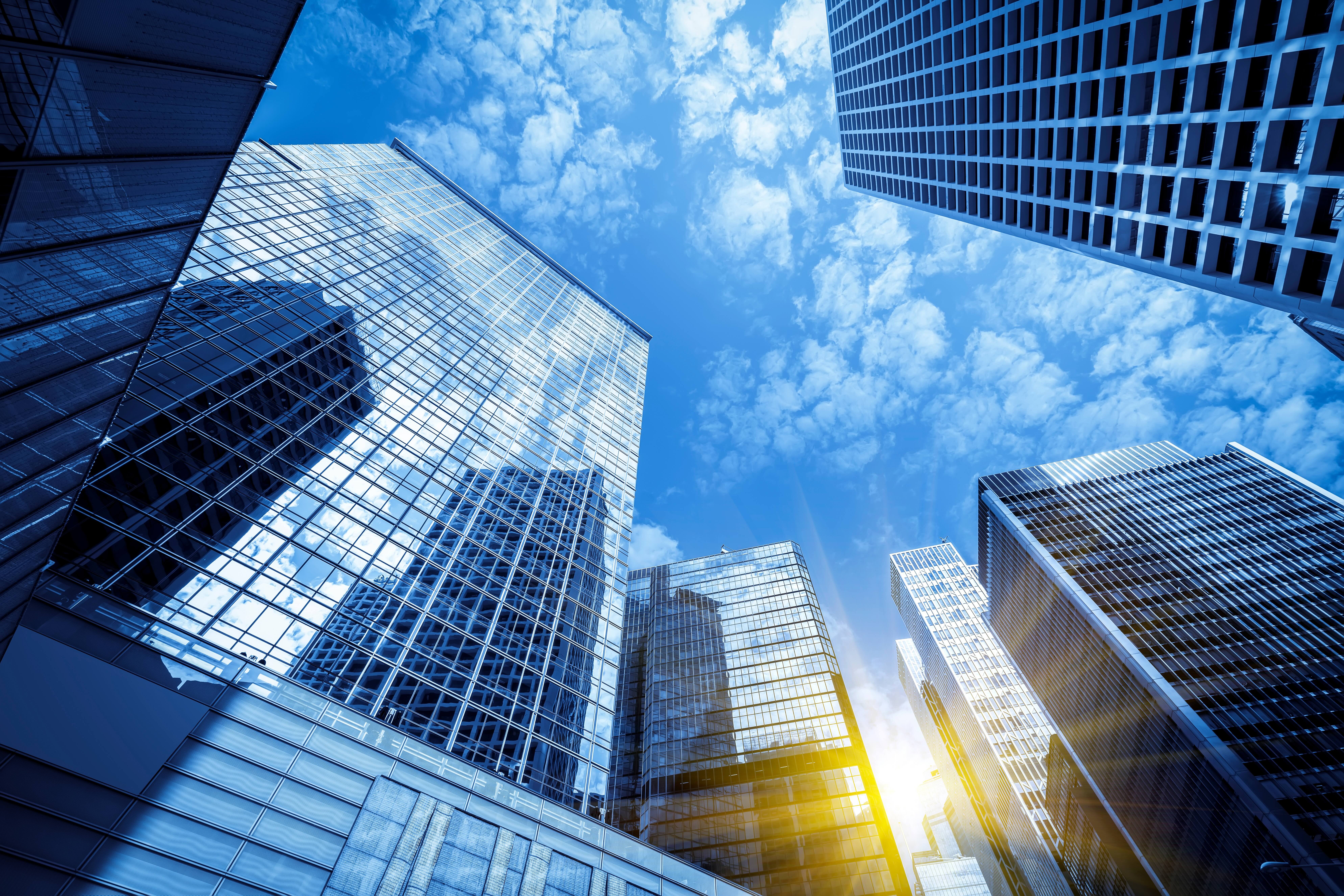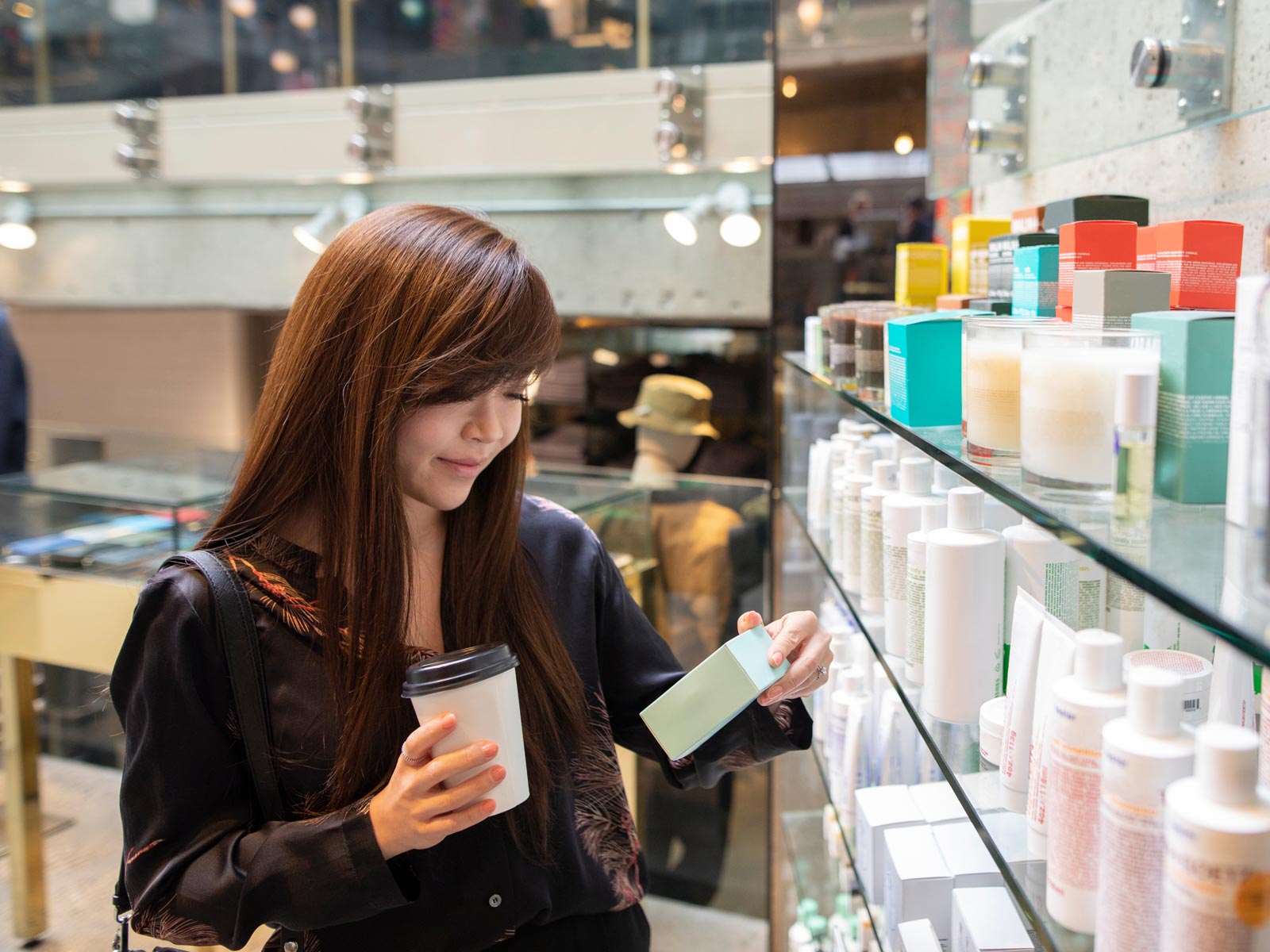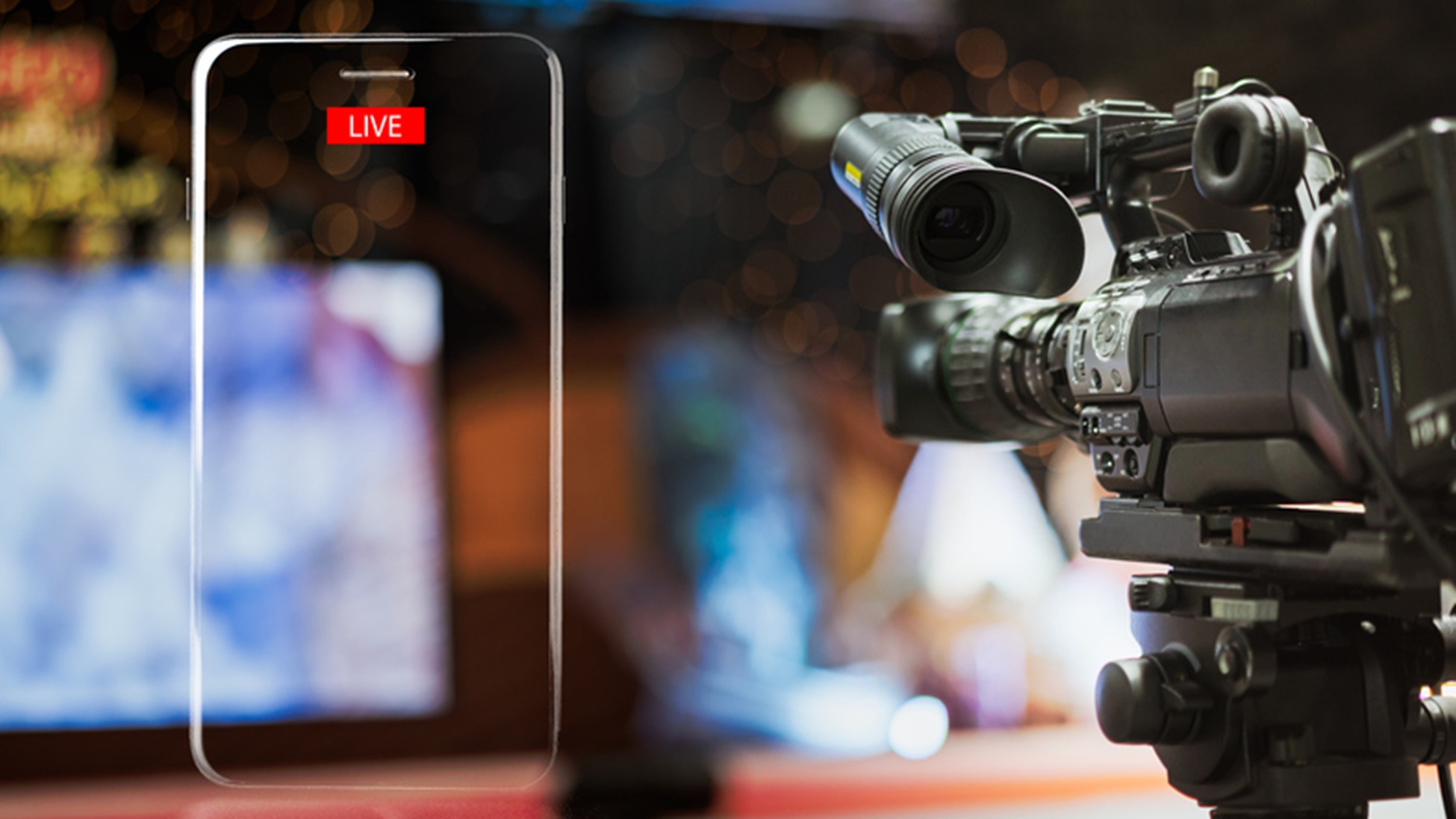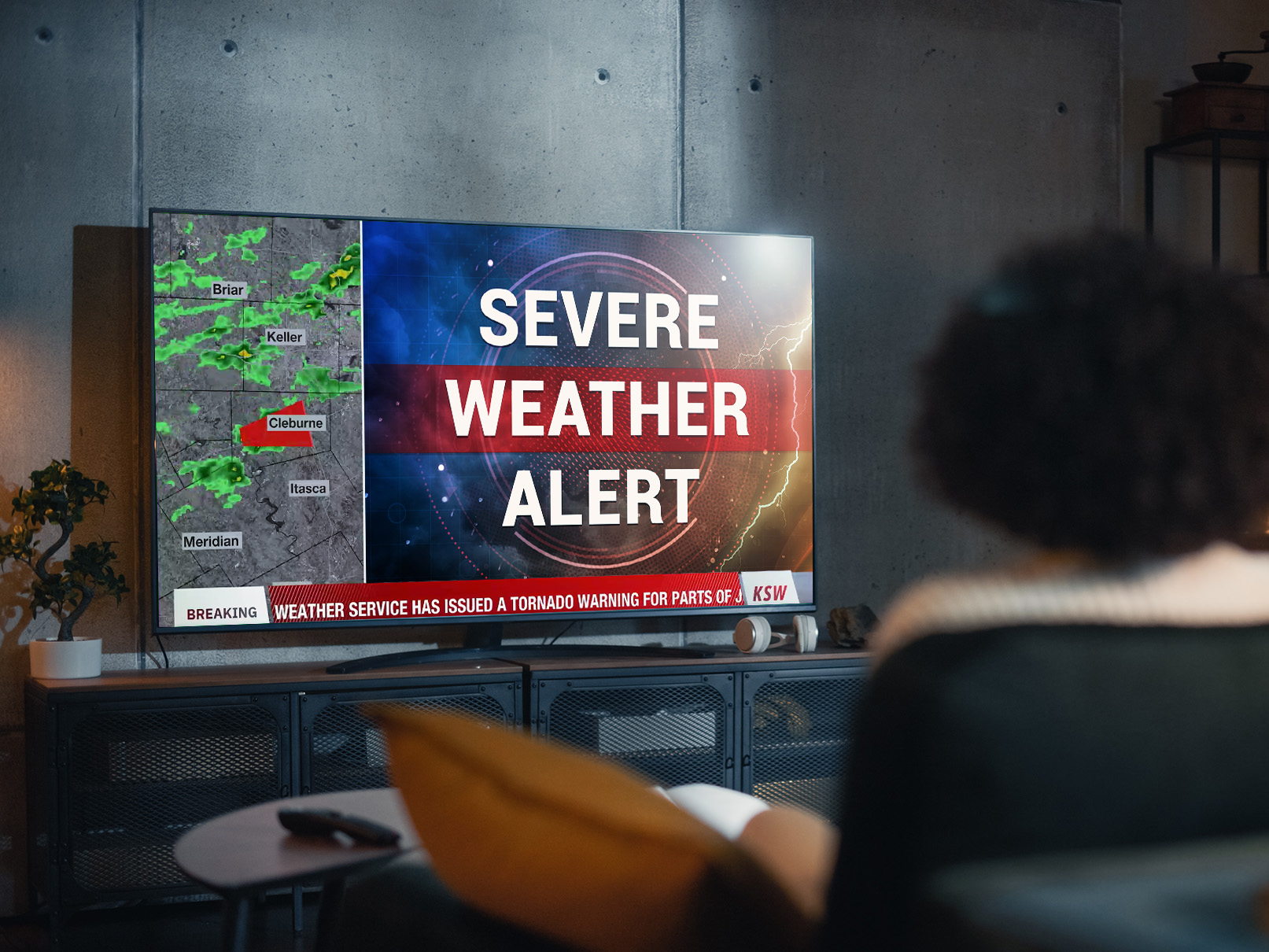Weather intelligence for the future: Crafting a strategic enterprise approach to changing environmental conditions
Continue readingViewers are increasingly interested in personalized content across mediums, and weather broadcasting is no exception. This growing demand is transforming how meteorological information needs to be delivered — and weather broadcasters need to answer the call.
By meeting viewers’ expectations for tailored information, weather broadcasters can increase engagement, trust, and reliance among their audiences, ensuring that the forecasts they provide are integral to each viewer’s planning of their day.
What is a custom weather forecast?
A custom weather forecast provides tailored meteorological information specific to an individual’s or business’s location and needs, rather than a broad, generalized forecast covering a large area. These forecasts typically focus on a particular city, town, or even a ZIP Code, providing detailed and relevant weather data that is immediately applicable to the viewer’s current surroundings. They also utilize advanced data modeling and meteorological technology to predict weather changes with high precision.
What are the advantages of custom weather forecasts?
Custom weather forecasts are revolutionizing how viewers interact with meteorological data, offering substantial advantages that extend beyond the basic provision of weather information.
1. Meeting demand
Viewers increasingly demand forecasts that cater specifically to their local environments. SmithGeiger research shows that 63% of viewers prefer forecasts targeted to their geographic areas, and 69% desire predictions narrowed down to their ZIP Codes. This high demand underscores the need for precision in meteorological services.
2. Improving trust
Personalized weather forecasts cater to specific viewer needs while also building trust. Viewers tend to rely more on forecasts that address their local weather conditions directly, enhancing their trust in your brand and ensuring consistent viewer engagement.
3. Increasing relevance
General forecasts often include details that may not apply to all areas covered, leading to viewer dissatisfaction. For example, a meteorologist may say it will be rainy tomorrow, but only one part of your city or town ends up wet. By focusing on relevant information, you can ensure that your content is of direct interest to your audience, thereby increasing viewer retention.
4. Helping viewers plan their day
Detailed, localized forecasts allow viewers to plan their activities with greater confidence, knowing how weather will affect their specific location throughout the day. This personalization addresses another common viewer grievance: the lack of specific timing for predicted weather changes.
5. Improving weather forecast accuracy
Custom weather forecasts significantly enhance accuracy by tailoring predictions to specific local conditions. By focusing on the unique aspects of each locality, custom forecasts provide more relevant and actionable information, thereby improving overall forecast accuracy. This is one of the reasons why The Weather Company is the world’s most accurate weather forecaster overall, according to a 2017-2022 study from ForecastWatch: Global and Regional Weather Forecast Accuracy Overview, 2017-2022, commissioned by The Weather Company. The Weather Company leverages localized data to ensure reliable predictions. This approach is crucial for viewers who depend on accurate weather forecasts for personal planning and safety.
Where can personalized weather forecasts show up?
Personalized weather forecasts have risen in popularity in recent years, becoming ubiquitous in a wide variety of mediums. Here’s just a few places where you may have noticed them:
Linear TV
Linear TV, the traditional model for television broadcasting, utilizes some localization for broadcasts through weather alerts. Because weather updates are scheduled at specific times, you can ensure that your viewers receive timely information tailored to their local area. This format is particularly used during weather emergencies or sudden changes, allowing you to interrupt regular programming to provide critical updates. With Max Alert Live, broadcasters can add a detailed map to their crawl down to the DMA level, so viewers can fully understand the impacted area. See example below.

CTV platforms
Connected TV (CTV) platforms turn regular TVs into smart TVs, allowing users to access a wide range of online services, including personalized weather content. According to SmithGeiger research, demand on CTV platforms is growing, with 21% of viewers wanting an on-demand customized forecast on a weather streaming service through these platforms. Through channels specifically designed for weather tracking, viewers can receive real-time updates, alerts, and detailed forecasts directly on their television screens for their precise location.
Mobile devices
Mobile devices are increasingly becoming a preferred platform for accessing personalized weather information, with 80% of viewers favoring mobile platforms for their weather updates according to SmithGeiger research. These devices offer unparalleled convenience and immediacy. Users can receive tailored forecasts that are specific to their exact location thanks to GPS technology, which enhances the relevance and accuracy of the information provided.
Out of home
The demand for accessible weather information while on the move is high, with SmithGeiger research finding that 49% of viewers value forecasts at airports, 42% on airplanes, and 34% at train or bus stops. These forecasts are crucial for travelers making informed decisions about the potential for travel delays, which activities to plan for a trip, and appropriate clothing to pack.
What to consider when building custom weather forecasts
When developing custom weather forecasts, it’s crucial to consider a variety of factors that directly impact their effectiveness and relevance for the intended audience. Understanding the nuances of custom weather forecasts will help you deliver the right messaging and information to your viewers every time.
Viewer location
Customizing forecasts at a hyperlocal level is key. Whether you’re targeting a city, town, or even a specific ZIP Code, detailed localization will ensure that each viewer receives information that’s relevant to their specific location.
Time of day
Providing hour-by-hour breakdowns, and in the case of severe weather, minute-by-minute updates, can significantly enhance the utility of a forecast. This detailed temporal resolution helps individuals and businesses make more informed decisions about their daily activities, particularly when planning weather-sensitive events or tasks.
Day of the week
Weekly forecasts help viewers plan their week ahead, especially when they include varied weather conditions expected over seven days. Offering a comprehensive seven-day forecast and highlighting their weekend forecast helps viewers plan their week more effectively.
Forecasted weather
Integrating predictive radar images, especially when rain or severe weather is anticipated, can improve the forecast’s usefulness. This visual tool helps viewers better understand the weather that may impact their area.
Severe weather
Providing timely and location-specific severe weather alerts is crucial for safety and preparedness. These alerts should be based on real-time weather data to ensure they are as accurate and relevant as possible.
Lifestyle and health forecasts
Including information on seasonal conditions makes weather forecasts more engaging and useful, particularly for viewers who regularly participate in outdoor activities. According to SmithGeiger research, 42% of viewers would like to see a day planner that lets them know how to plan outdoor activities. By incorporating detailed reports on pollen levels, humidity, and wind speeds, forecasts become comprehensive guides that help viewers manage their health and outdoor plans effectively. A golf, beach, or even running forecast are examples of other personalized weather content that can be delivered.
Develop personalized weather forecasts with ReelSphere
ReelSphere, from The Weather Company, offers a sophisticated platform to develop and broadcast personalized weather forecast videos across various channels. Leveraging AI and advanced meteorological tools, ReelSphere allows you to create detailed, engaging, and highly customized weather reels that meet the dynamic needs of today’s viewers.
By focusing on these detailed and specific forecasting needs, viewers receive tailored, timely forecasts. Learn more about how ReelSphere is opening up new possibilities for weather forecast personalization.
Let’s talk
To learn more about automated, digital weather streaming content with ReelSphere, contact our media experts today.
Contact usFrom streaming TV shows to buying products online, today’s consumers expect hyper-personalized experiences and round-the-clock services that fit their individual preferences. They have the same expectations for weather forecasts, with six in 10 viewers reporting a high level of interest in geographically specific forecasts.1
Hyperlocal weather data enables forecasters to curate content based on the viewer’s geography — moving beyond generic, one-size-fits-all forecasts to provide relevant weather information for specific locations and times. The integration of AI and automation has brought hyperlocal weather forecasting and content to a new level. This new technology facilitates the creation of video content based on location-specific conditions through the power of accurate weather data and AI voice-over technology.
Hyperlocal weather data enables more targeted, adaptive reports that can adjust to changing conditions in real time — ensuring consumers receive the most personalized, up-to-date weather information catered to their unique needs and preferences. Read on to learn how these advanced technologies are enhancing weather forecasting and content.
What is hyperlocal weather forecasting?
Hyperlocal weather forecasting is a specialized form of meteorology that pinpoints weather conditions to extremely localized areas, such as specific ZIP codes. This tailored approach allows for better access and a deeper understanding of weather data, offering significant advantages over traditional, broader-area weather forecasts.
Hyperlocal forecasting uses advanced weather modeling systems and data collection methods, such as IoT sensors, satellite imagery, and radar data, to generate precise weather predictions for small geographic areas. By delivering accurate, relevant, and location-specific weather information, hyperlocal forecasting significantly enhances user experience and satisfaction.
What platforms do viewers use for hyperlocal weather?
Audiences can receive and interact with hyperlocal weather forecasts through a variety of channels and platforms, including:
1. Mobile apps
Mobile apps are a primary touchpoint for consumers seeking weather forecasts, with 63% of viewers interested in seeing weather timelines and location-specific conditions over the next eight hours according to a recent SmithGeiger study. Mobile apps can use GPS data to deliver real-time weather updates specific to the user’s exact location, providing detailed predictions about temperature, precipitation, and other conditions. The convenience and immediacy of mobile apps make them a popular choice for individuals needing timely weather information on the go.
2. Weather website
Weather websites remain a vital resource for accessing hyperlocal weather forecasts. Users can enter their zip codes or allow location detection to receive localized weather reports. These sites often provide comprehensive weather details, including hourly forecasts, radar images, and long-term predictions.
3. Local TV news
Local TV news stations play a crucial role in delivering hyperlocal weather information. Through television broadcasts and associated online platforms, they provide updates tailored to specific communities and provide additional context that viewers cannot find on other platforms such as how the weather forecast might impact tomorrow’s parade or fair. Local meteorologists use regional data to give forecasts that are more relevant to the viewers’ immediate environments, which is also especially important during severe weather events. According to a recent SmithGeiger study, 49% of viewers look to local news for advanced warning of potential severe weather.
4. CTV
Consumers increasingly use connected TV (CTV) platforms to access their weather forecasts. TV is still one of the most preferred places to watch weather with 62% interested in seeing weather forecasts here according to a recent SmithGeiger study. Apps on these platforms can offer detailed weather updates directly on the user’s TV, combining the convenience of digital applications with the detailed, visual appeal of traditional TV weather forecasts.
How can AI be used in hyperlocal weather video content?
Advanced AI and automation are revolutionizing the way hyperlocal weather content is delivered, particularly through video. For instance, ReelSphere harnesses AI for voice-overs in weather forecasting videos, which enables the generation of narrated content that’s more accurate, engaging, and accessible to viewers. According to the same SmithGeiger study, 65% of viewers trust an AI-voiceover from their favorite meteorologist. In fact, AI-generated voiceover and regular voiceover performed about the same.
AI can also help broadcasters develop curated weather forecasts and dynamic video content that takes into account the day of the week, time of day, and other factors to offer a personalized view of what weather will look like in each user’s location. Broadcasters looking to stay competitive need to consider offering this level of personalization, since consumers are increasingly interested in hyperlocal forecasts for their exact location, ZIP code, and neighborhood. In fact, about 67% of viewers are willing to share areas and locations of interest to them.
What are the advantages of utilizing AI & automation for hyperlocal weather video content?
Hyperlocal forecasting provides precise weather updates at a granular level, offering significant advantages and benefits for viewers, including:
1. Relevance
The integration of AI and automation ensures highly relevant weather information and forecasts for viewers. It’s clear that consumers are eager for such content, with research showing that 69% of people are willing to share their zip code to receive forecasts tailored to their specific locations. By adapting weather forecasts for individual viewers, hyperlocal weather content removes information that audiences find irrelevant, zeroing in on how weather events are impacting local communities in real time.
2. Adjusting to demand
On clear days, users typically prefer succinct updates, whereas they expect more detailed forecasts when severe weather looms. Automated forecasts can adjust as consumer demand changes with weather conditions, such as adding a forecast radar when rain is expected or utilizing location-specific weather graphics. These technologies enable forecasters to alter content length and detail depending on weather conditions and viewers’ preferences.
3. Timeliness
AI and automation enable forecasts to be developed in near real-time. Timely information is most important during dangerous severe weather events, such as last year’s “super fog” in Louisiana that led to the pileup of hundreds of cars and, sadly, seven deaths. Automated systems ensure that vital weather information is generated and distributed quickly, reaching audiences when it is most needed.
4. Engaging audiences
Historically, meteorologists have had to manually update forecast videos for every location and hour. This manual process limited the precision of local forecasts to broader areas. However, now meteorologists can use AI to automatically update videos across platforms to keep audiences informed and engaged. Moreover, AI can enhance the tone and tenor of hyperlocal video content by integrating local meteorologists’ voices to make forecasts engaging, relevant, and trustworthy without slowing the production cadence
5. Streamline processes
Utilizing AI and automation for voice-overs can help streamline the creation of videos, making the process more timely, efficient, and scalable. With growing audiences and limited resources, AI-enhanced digital workflows play a crucial role in the production of content across multiple platforms — enabling meteorologists to meet increased demand for accessible and timely weather updates.
6. Provide more accurate updates
As weather patterns become more extreme, the ability to provide real-time, accurate weather updates is increasingly vital. AI-enhanced systems decrease the burden on meteorologists by making it easier to quickly share updates as weather conditions evolve. This allows consumers to make informed decisions based on the latest information, which is essential for safety and preparedness in an era of climatic unpredictability.
How accurate are automated hyperlocal weather forecasts?
Automated hyperlocal weather forecasts have significantly improved when it comes to accuracy. With advancements in technology and data analysis, meteorologists can provide individuals and industries with accurate weather information they can rely on when planning and making decisions.
In this video sample, experience a local forecast auto generated by ReelSphere, powered by AI.
These enhancements have led to notable achievements and recognition in the field. The Weather Company has been recognized as the world’s most accurate weather forecaster, according to a study by ForecastWatch, which studied global and regional weather forecast accuracy from 2017 to 2022.
Create hyperlocal weather video content and forecasts with ReelSphere
Viewers crave relevant, current, and engaging digital weather content that is available to them 24/7.
By leveraging AI and automating the creation of hyperlocal weather content, you can meet consumers precisely where they are — both geographically and in their desire for personalized digital content.
ReelSphere is at the forefront of transforming weather forecasting into a dynamic, on-demand experience tailored for digital platforms. ReelSphere enables you to deliver highly personalized, hyperlocal weather videos and content without additional production resources.
Let’s talk
To learn more about automated, digital weather streaming content with ReelSphere, contact our media experts today.
Contact us1 According to a 2024 ReelSphere Research Study from SmithGeiger on behalf of The Weather Company.
One-size-fits-all weather content is no longer enough for today’s audiences.
As technology evolves and viewer preferences shift, the demand for highly localized, up-to-the-minute weather information is rapidly growing. Weather broadcasters need a new model to meet these preferences, one that isn’t bound by the constraints of traditional broadcast schedules.
This is where Connected TV (CTV) broadcasts become so essential.
What is CTV weather broadcasting and how does it work?
CTV weather broadcasting refers to the delivery of weather-related content through CTV devices such as Xbox, Roku, Apple TV and more. These devices connect to or are embedded in televisions to stream content over the internet.
In the context of weather broadcasting, CTV allows broadcasters to deliver real-time weather updates, forecasts, severe weather alerts, and other related content directly to viewers’ televisions via the internet. This approach leverages the interactivity and connectivity of digital media, allowing for more personalized and location-specific content. For instance, CTV viewers can access weather updates that are tailored to their exact location at any time, not just during scheduled broadcast times.
Through the integration of real-time data from satellites, radar, and weather stations, CTV systems process and tailor weather forecasts specific to each viewer’s location. This customization allows for a more personalized and engaging experience, enabling viewers to interact with the broadcast using their remote controls to explore in-depth weather maps and extended forecasts.
What is the difference between traditional and CTV weather broadcasts?
Traditional (or linear TV) weather broadcasts have been primarily broadcast Over the Air (OTA) or on cable, often at fixed times and with general content intended for broad audiences. In contrast, CTV weather broadcasts leverage the flexibility of online streaming platforms, offering viewers the ability to access weather updates at their convenience across a variety of platforms. This level of personalization makes CTV a better fit for today’s audiences, who expect access to real-time, relevant weather updates across a variety of devices.
What is the difference between OTT and CTV weather broadcasts?
While both Over-the-Top (OTT) and Connected TV (CTV) broadcasting are related, they are different. OTT encompasses the broader method of delivering streaming content. For example, viewers can watch live weather updates or emergency broadcasts directly on their mobile devices through apps like The Weather Channel app, which provides real-time alerts and forecasts wherever they are.
CTV, on the other hand, specifically refers to the internet-connected TV devices. The viewing experience mimics a traditional TV format but with modern connectivity features. Viewers can use these devices to stream dedicated weather channels that offer continuous live broadcasts and specialized content such as local weather reports tailored to their exact locations. CTV weather broadcasts are designed for these kinds of devices and are distributed via streaming channels.
An overview of CTV components
Viewers can access CTV weather broadcasts through a variety of devices and methods, including the following:
Smart TVs
Smart TVs’ integrated internet capabilities allow direct streaming of weather broadcasts, enabling viewers to access real-time weather information with just a few clicks on their remote controls.
Digital Media Players
Digital media players are devices that stream digital content to TVs, such as Chromecast, Amazon Fire Stick, and video game consoles. These devices allow users to switch seamlessly between watching their favorite shows and viewing the latest weather updates.
Set-Top Boxes
Cable boxes that provide internet connectivity and access to a plethora of streaming services also enable easy access to weather channels and apps.
Advantages of CTV weather broadcasting
The advanced streaming technology that powers CTV broadcasting has tremendous potential for improving your weathercasts. Here are just a few advantages that you can expect:
Cost-effective
CTV broadcasting has lower operational costs because of their simplified content distribution processes. It allows you to automate video creation and share content across multiple channels, reducing the need for extensive manual intervention.
Faster delivery
As broadcasting expands to include digital platforms and CTV alongside traditional linear TV, the need to quickly produce and distribute content has become critical. ReelSphere, a tool enhanced with AI, streamlines this process by automatically generating weather content. It allows you to create targeted, hyperlocal, and adaptive videos based on the forecast, day of the week and other factors. Being able to generate these videos across multiple channels helps ensure that your viewers receive weather information in a timely fashion.
Reaches a larger audience
CTV broadcasting effectively expands audience reach by leveraging advanced technologies to serve tailored weather videos across all digital platforms. For example, allowing on-air talent to incorporate viewer-submitted stories and social media posts into broadcasts. This approach allows you to tap into a broader demographic, including viewers who primarily consume content on mobile devices and online platforms.
Recent research supports this strategy, showing that 88% of respondents are at least somewhat interested in using local weather streaming services. By utilizing hyperlocal weather broadcasting tools, you can ensure that weather content is both accessible and relevant for local viewers.
Engagement
Weather broadcasting directly impacts people’s daily decisions, making it inherently engaging and important to viewers. For example, viewers stream CBS News Colorado’s digital weather content for an average of more than 30 minutes per day. This high level of engagement makes weather content a pivotal part of their streaming strategy, according to meteorologist Ashton Altieri.
Ability to scale hyperlocal content
With the right CTV weather content solution, you can effectively create targeted and hyperlocal videos at scale. This capability ensures that audiences in different regions receive weather updates that are tailored to their specific local conditions, meeting the growing demand for extremely targeted, relevant content. For example, showing the radar map only when there is precipitation in the forecast.
Though CTV solutions streamline workflows with weather forecast automation features, your team still retains the flexibility to manually edit and refine the content. This blend of automation and manual oversight ensures that you can maintain quality and accuracy even as your production of weather content scales up.
Advertising opportunities
CTV weather broadcasting opens up lucrative advertising opportunities that can significantly enhance revenue streams for your channel. Essentially, localized content provides an opportunity for extremely localized advertising that’s relevant to your viewers. In addition, according to the “Weather OTT Focus Groups & Quantitative Survey” conducted by Magid Research, 98% of advertisers would consider sponsoring weather content on CTV. With the increasing shift toward digital and connected media, weather streaming on CTV platforms presents a fresh and attractive avenue for monetization.
First-party data
Leveraging first-party data is a powerful strategy for CTV weather broadcasting, enabling your station to better target and deliver lifestyle videos that cater precisely to its viewers’ preferences and locations. By collecting and analyzing viewer data, such as viewing habits, preferred content types, and geographical information, you can tailor your weather broadcasts to enhance relevance and viewer engagement such as offering a golfer’s, beach or even runner’s forecast.
Create professional CTV weather broadcasts with ReelSphere
The Weather Company’s ReelSphere solution revolutionizes weather broadcasting by automating the production of on-demand, personalized weather content for CTV and OTT platforms. Leveraging the power of their Max platform and graphics, ReelSphere enables you to deliver curated content at the drop of a hat. The system automatically generates location-specific weather graphics and broadcast templates that vary depending on the time of the day and the existing weather conditions. By letting you scale up localized weather content quickly and efficiently, without expending additional resources, ReelSphere lets you harness the full benefits of the CTV streaming revolution.
People also asked questions
What weather software do meteorologists use?
Meteorologists use a range of sophisticated software tools designed to collect, analyze, and present weather data. These tools include models that predict weather patterns based on current atmospheric conditions gathered from satellites, radar, and ground-based sensors. They also use geographic information systems (GIS) to visually represent weather data on maps, which helps in analyzing and forecasting weather more effectively. Additionally, specialized software like Max helps meteorologists create visual representations of the weather for public broadcasts.
What weather data and model are most accurate?
Determining the most accurate weather data often depends on the region, forecast type, and specific weather events. No model is perfect. Public data from the National Weather Service (NWS) is renowned for its comprehensive and reliable forecasts, thanks to extensive data from satellites and radars. The Weather Company is the world’s most accurate weather forecaster overall, according to a 2017-2022 study from ForecastWatch: Global and Regional Weather Forecast Accuracy Overview, 2017-2022, commissioned by The Weather Company.
Let’s talk
To learn more about automated, digital weather content with ReelSphere, contact our media experts today.
Contact usIt takes a lot of effort for weather broadcasters to capture and keep their audience’s attention at a time when viewership is becoming increasingly fractured. It requires a mix of engaging graphics, accurate, up-to-date information, and high production quality to deliver broadcasts that resonate.
Striking the right balance is critical — after all, weather broadcasters play a pivotal role in bridging the gap between complex meteorological data and the public’s need for accessible and actionable weather information. To disseminate critical information quickly and in a compelling format, broadcasters need live broadcasting software that’s versatile enough to handle the many nuances of weather reporting.
Your live broadcasting software should empower your team of meteorologists and weather reporters to transform raw data into comprehensible and visually appealing broadcasts that can inform, educate, and sometimes even entertain viewers. Whether it’s tracking a storm in real-time, providing evacuation routes during a hurricane, or explaining the science behind a heatwave, the software that enables your broadcasts needs to ensure precision, speed, and clarity in every weather report.
What is live broadcasting software used for?
Live broadcasting software has become an essential tool in the meteorological and media fields, particularly for reporting severe weather events such as thunderstorms, wildfires, tornadoes, blizzards, and hurricanes. This technology enables real-time dissemination of crucial weather updates and information, leveraging advanced tools like satellites and weather radars to predict weather patterns. Your team can use these tools alongside forecasting models to issue alerts and provide the public with actionable information.
Of course, weather content is most relevant when it’s focused on a viewer’s local region. But delivering hyperlocal content at scale is difficult because it requires significant resources, both in terms of technology and human expertise.
Live broadcasting software minimizes these challenges. It has been instrumental in powering 24/7 weather streaming services with hyperlocal content for communities across the globe. As audiences — especially younger generations — begin to favor streaming services, this technology enables you to reach viewers directly on their preferred platforms.
What are the advantages of broadcasting weather live?
Live weather broadcasts have been a local news staple for decades. But what’s groundbreaking is the ability to stream real-time updates 24/7 from anywhere. Viewers can gain access to valuable weather information right when they need it — without having to wait until the 6 o’clock news rolls around.
Timely
No matter where viewers live or what devices they use, live broadcasting software enables you to reach them with immediate weather updates for their local area. This is especially critical when weather conditions change rapidly because the accuracy of the information can significantly impact viewers’ decisions and safety. Live broadcasting software empowers your team to support real-time updates across streaming channels for every locality you serve without scaling staff or resources.
Highly engaging
Live weather broadcasts have the power to captivate audiences. Ashton Altieri from CBS Colorado noted that platforms like over-the-top (OTT) streaming channels have seen increased viewer engagement, with audiences dedicating a significant amount of time to consuming weather content. This engagement is critical for maintaining and growing your viewer base at a time when fewer households consume weather reports through traditional news broadcasts.
Loyalty
According to research commissioned by Magid and The Weather Company, only 44% of viewers use cable or satellite as a primary source for weather updates on TV. This means that there’s a tremendous opportunity to drive audience engagement by offering more relevant and personalized live weather broadcasts — especially for streamers. More than a third (40%) of all TV viewership is now streaming-related. By offering live streaming options, your company can capture more of this audience share.
Reusable
A robust weather broadcast software lets you repurpose content from live broadcasts across multiple channels, maximizing reach and engagement. This versatility allows you to leverage social media platforms, websites, and mobile apps to make your broadcast content accessible to audiences, wherever they are.
Revenue opportunities
Expanding beyond linear broadcasting into live connected television (CTV) presents a lucrative opportunity for boosting your company’s revenue potential. Magid predicts the CTV revenue stream will grow from $2.7 billion to $3.5 billion by 2027. Additionally, 98% of broadcasters are interested in sponsoring weather content on CTV and OTT platforms.
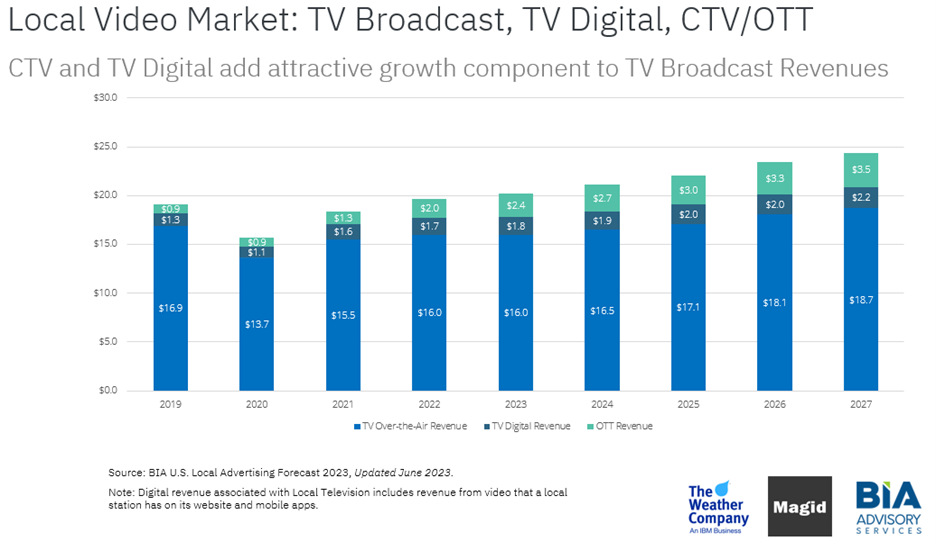

The advantage of CTV and OTT advertising lies in their capacity for hyperlocal targeting, offering advertisers unprecedented precision in reaching specific markets and tailoring campaigns to local audiences. This is especially attractive for advertisers that have historically invested in ad placements on local TV stations, including legal service providers, hospital networks, and car dealerships.
Where can a live weather broadcast software be used?
Live weather broadcast software can enhance all aspects of weather programming, from the newsroom to the field. Here are just a few ways live weather broadcast software can be used to deliver more high-quality reports.
Newsroom broadcasts
Live broadcasting software is vital in newsrooms for swiftly creating and sharing weather reports and alerts, keeping viewers well-informed when they need it most. During a broadcast, every second matters, which makes having a seamless, responsive software infrastructure essential.
Reporting on-location
Remote broadcasts transmit video and audio content from remote locations back to your studio using digital video transmission, cloud-based platforms, and remote control systems. This setup gives your team of meteorologists greater flexibility in how they cover specific weather conditions. On-location reporting lends immediacy to weather updates. It offers viewers firsthand insights into weather conditions, making the information more relevant and engaging. This approach also adds a human touch to weather reporting that is difficult to replicate. When paired with tools like augmented reality, reporting outdoors or outside of the typical studio can immerse an audience into a whole new world of storytelling.
6 key considerations for a live weather broadcast software
Not all live broadcast software is created equal. The right software for your organization will depend on your specific needs and preferences. Ask yourself what features are non-negotiable, and begin your search from there.
1. Streamlined workflow
Software with streamlined weather broadcast workflow capabilities can help you create and distribute weather content from any location, at any time. This flexibility allows for seamless collaboration among remote and hybrid team members, eliminating production delays that prevent you from delivering real-time weather updates across channels.
2. Simple to manage
The ideal live broadcast solution should enable your team to create and distribute weather content without needing extensive technical skills or advanced hardware. These features include user-friendly interfaces, preset broadcast templates for quick content creation, and automatic updates to ensure the software remains current without manual intervention.
3. Cloud storage
Prioritize the integration of cloud storage in your broadcasting software selection. This essential feature helps ensure that live streams and generated content are securely backed up and easily accessible for future use across various mediums.
4. Asset library
Access to a well-organized asset library containing pre-developed weather graphics, templates, and other resources aligned with brand guidelines supports the production of professional and consistent live streams. This repository is invaluable for maintaining brand identity and enhancing the visual appeal of weather broadcasts, especially when you’re moving fast to publish real-time severe weather alerts and warnings.
5. Accuracy & speed
Weather consumers want faster access to information and more up-to-date reports on severe weather, according to a report commissioned by Magid and The Weather Company. Live broadcast software can help you automate content delivery with minimal manual oversight.
The most robust solutions employ sophisticated models, analysis tools, and data feeds that enable your team to improve predictions and deliver accurate forecasts. For example, The Weather Company integrates with the National Weather Service (NWS) to ensure broadcasts always utilize up-to-date weather data from an authoritative source. The Weather Company’s Max Alert Live solution actually has a direct integration with the NWS so alerts are automatically surfaced in order to be the first to air with live-saving information.
6. Production quality
Poorly produced weather segments distract viewers, leading them to tune out your broadcasts. High-quality video production can keep audiences engaged — and you don’t need big teams of professional videographers and animators to pull it off. As a bonus, you can unlock more advertising opportunities, especially in hyperlocal markets, as your volume of published content increases without risking quality.
Broadcast software that’s easy for teams to use with minimal training can take your production quality to the next level. In particular, features like augmented reality can significantly enhance the viewer experience, making complex weather information more understandable and visually appealing. Viewers often tune out standard weather graphic illustrations, but augmented reality can make weather reports more cinematic and engaging. Ultimately, the technology opens up new avenues for creativity in weather storytelling.
Share your broadcast live streams from anywhere at any time with Max Velocity
The Weather Company’s Max Velocity solution is at the cutting edge of broadcast software, enabling broadcasters to produce and share compelling weather content on various digital platforms from anywhere at any time efficiently.
By automating content creation and leveraging advanced broadcast software, Max Velocity allows for personalized, hyperlocal weather reports and alerts. This not only increases engagement across digital platforms but also provides your team of meteorologists with the tools to deliver impactful weather stories.
Interested in hearing more about how Max Velocity and other advanced broadcasting software can take your weather reports to the next level? Get in touch today to get the conversation started.
Let’s talk
To learn more about choosing the right live weather broadcasting software, contact our media experts today.
Contact us